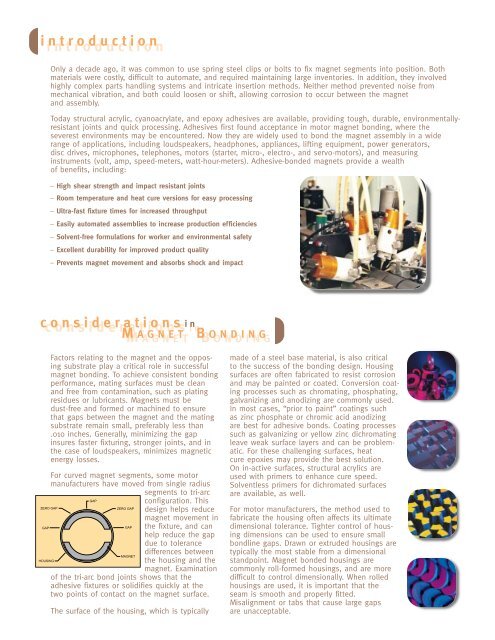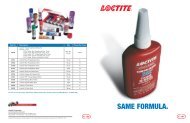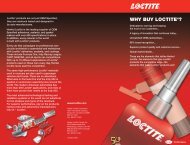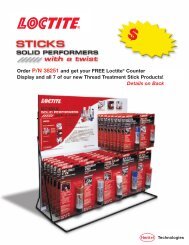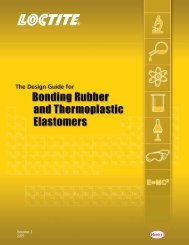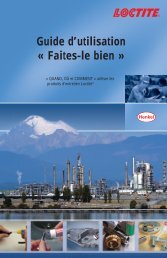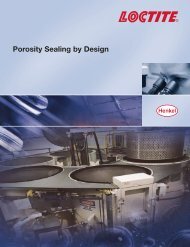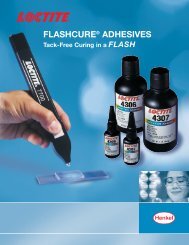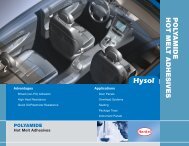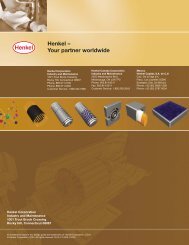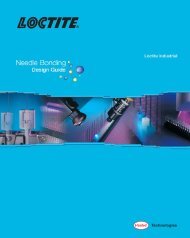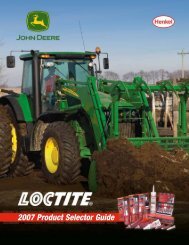magnet bonding for pdf - Loctite.ph
magnet bonding for pdf - Loctite.ph
magnet bonding for pdf - Loctite.ph
You also want an ePaper? Increase the reach of your titles
YUMPU automatically turns print PDFs into web optimized ePapers that Google loves.
introductionintroductionOnly a decade ago, it was common to use spring steel clips or bolts to fix <strong>magnet</strong> segments into position. Bothmaterials were costly, difficult to automate, and required maintaining large inventories. In addition, they involvedhighly complex parts handling systems and intricate insertion methods. Neither method prevented noise frommechanical vibration, and both could loosen or shift, allowing corrosion to occur between the <strong>magnet</strong>and assembly.Today structural acrylic, cyanoacrylate, and epoxy adhesives are available, providing tough, durable, environmentallyresistantjoints and quick processing. Adhesives first found acceptance in motor <strong>magnet</strong> <strong>bonding</strong>, where theseverest environments may be encountered. Now they are widely used to bond the <strong>magnet</strong> assembly in a widerange of applications, including loudspeakers, head<strong>ph</strong>ones, appliances, lifting equipment, power generators,disc drives, micro<strong>ph</strong>ones, tele<strong>ph</strong>ones, motors (starter, micro-, electro-, and servo-motors), and measuringinstruments (volt, amp, speed-meters, watt-hour-meters). Adhesive-bonded <strong>magnet</strong>s provide a wealthof benefits, including:– High shear strength and impact resistant joints– Room temperature and heat cure versions <strong>for</strong> easy processing– Ultra-fast fixture times <strong>for</strong> increased throughput– Easily automated assemblies to increase production efficiencies– Solvent-free <strong>for</strong>mulations <strong>for</strong> worker and environmental safety– Excellent durability <strong>for</strong> improved product quality– Prevents <strong>magnet</strong> movement and absorbs shock and impactconsiderationsconsiderationsininMAGNETMAGNETBONDINGBONDINGZERO GAPGAPHOUSINGFactors relating to the <strong>magnet</strong> and the opposingsubstrate play a critical role in successful<strong>magnet</strong> <strong>bonding</strong>. To achieve consistent <strong>bonding</strong>per<strong>for</strong>mance, mating surfaces must be cleanand free from contamination, such as platingresidues or lubricants. Magnets must bedust-free and <strong>for</strong>med or machined to ensurethat gaps between the <strong>magnet</strong> and the matingsubstrate remain small, preferably less than.010 inches. Generally, minimizing the gapinsures faster fixturing, stronger joints, and inthe case of loudspeakers, minimizes <strong>magnet</strong>icenergy losses.For curved <strong>magnet</strong> segments, some motormanufacturers have moved from single radiussegments to tri-arcGAPZERO GAPGAPMAGNETconfiguration. Thisdesign helps reduce<strong>magnet</strong> movement inthe fixture, and canhelp reduce the gapdue to tolerancedifferences betweenthe housing and the<strong>magnet</strong>. Examinationof the tri-arc bond joints shows that theadhesive fixtures or solidifies quickly at thetwo points of contact on the <strong>magnet</strong> surface.The surface of the housing, which is typicallymade of a steel base material, is also criticalto the success of the <strong>bonding</strong> design. Housingsurfaces are often fabricated to resist corrosionand may be painted or coated. Conversion coatingprocesses such as chromating, <strong>ph</strong>os<strong>ph</strong>ating,galvanizing and anodizing are commonly used.In most cases, “prior to paint” coatings suchas zinc <strong>ph</strong>os<strong>ph</strong>ate or chromic acid anodizingare best <strong>for</strong> adhesive bonds. Coating processessuch as galvanizing or yellow zinc dichromatingleave weak surface layers and can be problematic.For these challenging surfaces, heatcure epoxies may provide the best solution.On in-active surfaces, structural acrylics areused with primers to enhance cure speed.Solventless primers <strong>for</strong> dichromated surfacesare available, as well.For motor manufacturers, the method used tofabricate the housing often affects its ultimatedimensional tolerance. Tighter control of housingdimensions can be used to ensure smallbondline gaps. Drawn or extruded housings aretypically the most stable from a dimensionalstandpoint. Magnet bonded housings arecommonly roll-<strong>for</strong>med housings, and are moredifficult to control dimensionally. When rolledhousings are used, it is important that theseam is smooth and properly fitted.Misalignment or tabs that cause large gapsare unacceptable.
<strong>magnet</strong> <strong>bonding</strong>BLOCKSHEAR AND IMPACT STUDYSubstrate Magnet Blockshear Bond Strength, Impact Bond Strength per(block) psi, per ASTM D4501 ASTM D950 up to 10 ft.-lb.Product 392/7387Avg. Predominant Failure Mode Impact Value PredominantFailure ModeMild Steel Ferrite 2749 Adhesive Failure to Magnet >10 MagnetMild Steel Alnico 2951 Adhesive Failure to Magnet >10 NoneMild Steel Neodymium 2998 Adhesive Failure to Magnet >10 AdhesiveE-coat Ferrite 2698 Magnet Substrate Failure >10 MagnetE-coat Alnico 2926 Block Substrate Failure 5.9 AdhesiveE-coat Neodymium 2467 Block Substrate Failure >10 MagnetZn. dichr. Ferrite 1497 Adhesive Failure to Block >2.6 AdhesiveZn. dichr. Alnico 1993 Block Substrate Failure 6.6 AdhesiveZn. dichr. Neodymium 2071 Block Substrate Failure >7.3 MagnetProduct 332/7387Mild Steel Ferrite 1440 Adhesive Failure to Magnet >10 MagnetMild Steel Alnico 2651 Adhesive Failure to Magnet >10 NoneMild Steel Neodymium 3183 Cohesive Failure >10 MagnetE-coat Ferrite 1239 Adhesive Failure to Block 6.5 AdhesiveE-coat Alnico 2180 Cohesive Failure 8.7 AdhesiveE-coat Neodymium 1695 Cohesive Failure >6.8 MixedZn. dichr. Ferrite 668 Adhesive Failure to Block >1.1 AdhesiveZn. dichr. Alnico 729 Adhesive Failure to Block 5.6 AdhesiveZn. dichr. Neodymium 964 Adhesive Failure to Block >6.6 MixedProduct 326/7649Mild Steel Ferrite 1455 Mixed Mode >10 MagnetMild Steel Alnico 1574 Adhesive Failure to Block >10 NoneMild Steel Neodymium 1418 Adhesive Failure to Block >10 MixedE-coat Ferrite 901 Adhesive Failure to Block >7.0 MagnetE-coat Alnico 2643 Block Substrate Failure 8.1 AdhesiveE-coat Neodymium 908 Adhesive Failure to Block >9.9 Magnet/AdhesiveZn. dichr. Ferrite 1292 Adhesive Failure to Magnet >10 MagnetZn. dichr. Alnico 1590 Block Substrate Failure 7.0 AdhesiveZn. dichr. Neodymium 1590 Block Substrate Failure >7.1 MixedProduct E-214HPProduct 380Mild Steel Ferrite 4774 Magnet Substrate Failure >10 MagnetMild Steel Alnico 7775 Adhesive Failure to Block >10 NoneMild Steel Neodymium 5891 Adhesive Failure to Magnet >10 MagnetE-coat Ferrite 4616 Block Substrate Failure >10 MagnetE-coat Alnico 5930 Block Substrate Failure >10 NoneE-coat Neodymium 4638 Block Substrate Failure >10 MagnetZn. dichr. Ferrite 4462 Block Substrate Failure >9.8 MagnetZn. dichr. Alnico 4574 Block Substrate Failure 9.3 AdhesiveZn. dichr. Neodymium 4918 Block Substrate Failure >8.6 MixedMild Steel Ferrite 1987 Adhesive Failure to Block >9.2 MagnetMild Steel Alnico 2656 Adhesive Failure to Block >10 NoneMild Steel Neodymium 1515 Adhesive Failure to Block >10 MagnetE-coat Ferrite 2406 Magnet Substrate Failure >8.9 AdhesiveE-coat Alnico 3593 Block Substrate Failure >9.8 NoneE-coat Neodymium 3077 Block Substrate Failure >10 MagnetZn. dichr. Ferrite 1410 Adhesive Failure to Block >8.5 MagnetZn. dichr. Alnico 1615 Block Substrate Failure 4.9 AdhesiveZn. dichr. Neodymium 2508 Adhesive Failure to Block >10 MagnetNote: If only a value is given, it represents an average. If “>” and a value is given, it represents a minimum sample group value.
technical productin<strong>for</strong>mationProduct Number/Activator 392/7387 332/7387 326/7649 E-214HP 380Key Product Ultra Fast, Highest Thermal, Fast Fixturing, High Strength, Low Viscosity,Features High Thermal Impact & Shock High Strength Heat Cure Small GapsResistance ResistanceChemical Type Modified Modified Acrylic Urethane Epoxy CyanoacrylateAcrylicMethacrylateEsterViscosity, cP 60,000 200,000 18,000 150,000 200Cure Speed Fixture 30 seconds 1 minute 40 seconds 40 minutes @120°C 15 secondsFull 24 hours 24 hours 24 hours 24 hours 24 hoursFor additional Technical In<strong>for</strong>mation, request Technical Data Sheets and Material Safety Data Sheets by calling 1-800-562-8483.orderingin<strong>for</strong>mationProduct Number 392 332 Activator 326 Activator E-214HP 3807387 764925 ml Syringe 39205 3320130 ml Cartridge 2933950 ml Bottle 39250 32629300 ml Cartridge 39275 33275 293401 Liter Bottle 39280 33290 32685Pails 17507 17601 2934115 liters 12 liters 5 gallons1 oz Bottle 380501 lb Bottle 380612 kg Bottle 184941.75 oz Bottle 18861 1926925 gm Aerosol Can 213474.5 oz Aerosol Can 21088 213481 qt Can 188621 gallon Can 19266


